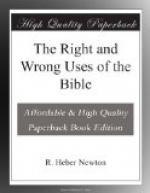Tradition has credited Ezra, the priestly coadjutor of Nehemiah, with the first formation of the Old Testament Canon. The two traditions express one and the same fact from the secular and ecclesiastical points of view. In the exile, the stricken nation came to value and honor its national heritage as never before. Its literary sense was quickened by close contact with the civilization of Babylonia, whose great library constituted one of the chief treasures of the central city. It was natural that on their return to their native land the Jews should gather their race-writings and found a National Library.
The genius of Israel had always been religious. Its very literature was pre-eminently religious. That their venerable writings should be received as sacred was thus wholly natural. They were in reality sacred writings.
Moreover, a large part of these writings, and that part largely drawn from very ancient times, was composed of judicial decisions, legislative codes, etc., around which veneration properly gathered. This veneration was heightened by the popular traditions which assigned to Moses the bulk of their legislation, and traced it through him to Jehovah himself. During the exile a remarkable priestly development, which had been running on through two centuries, at least, culminated in a completely organized hierarchy and an elaborate cultus.
In the process of this final development in Babylonia the legislation and histories of the nation were worked over by priestly hands in the priestly spirit. The law of Moses was now for the first time completely set before the people, and on the restoration to Judea was made the law of the land. It became, therefore, in a new sense sacred.
The fresh, free inspirations of the prophets—inspirations most real and divine—died out in the exile, smothered partly by this priestly development.[12]
When no living prophet arose to make men hear the voice of God, men had to hearken for that voice in the words of the dead prophets. In the synagogues or meeting-houses which developed during the exile, when the holy temple was in ruins, and which, having been found useful, were continued in the restoration, the writings of the prophets were read each Sabbath. The true writings of the chief prophets had therefore to be indicated. Thus came the canon of the prophets.
The freedom with which the author of the Chronicles used the material of the older historians which had been taken up into the sacred writings, shows that the sacredness attached to them had not isolated them into extra-human writings even a century and a half after Ezra.
The process of exaltation was at work, however, and continued thenceforth through the national history, increasing as the life of the nation ebbed. It was the period immediately following the destruction of Jerusalem by the Romans, which busied itself in closing the canon of Jewish Scriptures Death bound up that Bible. No new chapters could be added, because there was no more life left to write them. In its dotage this noble nation became known, by its superstitious reverence for the law, as “the people of the book.” Learned doctors gravely taught their pupils that “God himself studies the law for the first three hours of every day.”




